Dr. Firdaus Samad and Arindam Biswas underscore the issue of rampant waste production from the fashion industry and the rise in thrift shops and upcycled garments as a viable alternative for long term sustainability.
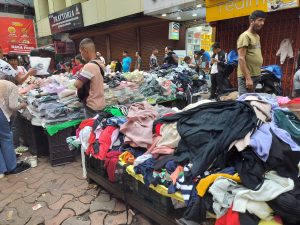
The global fashion industry faces an escalating crisis of textile waste, with approximately 92 million tonnes of clothing discarded annually—equivalent to a truckload of garments being dumped in landfills every second. This alarming trend, propelled by the fast fashion model, not only overwhelms landfills but also significantly contributes to environmental degradation through water contamination and greenhouse gas emissions, leading to various public health issues. As the industry continues to expand, the imperative for sustainable practices grows. The Thrift Fashion economy in Meghalaya presents a promising alternative that could reshape this narrative, especially given the region’s limited waste management infrastructure. By embracing second-hand clothing and promoting circular fashion practices, Meghalaya’s thrift economy offers a localised solution to a global problem, potentially mitigating environmental impact while providing affordable fashion options to its residents.
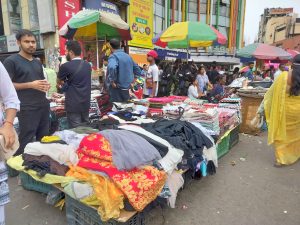
Fashion’s Footprint: Unravelling the Environmental Impact
The rise of fast fashion, characterised by rapid production cycles and low-cost garments, has significantly contributed to the increase in textile waste. Consumers are encouraged to buy more and discard clothes quickly, fostering a throwaway culture. According to Earth.Org, this model has led to the production of around 100 billion garments each year, with 85% ending up in landfills. The United Nations Environment Programme (UNEP) and the Ellen MacArthur Foundation report that the fashion industry is responsible for 20% of global wastewater and 10% of carbon emissions. The production and disposal of garments involve substantial water and energy 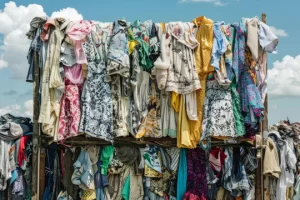 consumption. For instance, the World Wildlife Fund (WWF) states that it takes 2,700 liters of water to produce a single cotton t-shirt, enough for one person to drink for 900 days. In India, approximately 7.8 million tonnes of textile waste are generated annually, accounting for 8.5% of the global total. This waste includes both pre-consumer waste (42%) from production processes and post-consumer waste (51%) from discarded clothing.
consumption. For instance, the World Wildlife Fund (WWF) states that it takes 2,700 liters of water to produce a single cotton t-shirt, enough for one person to drink for 900 days. In India, approximately 7.8 million tonnes of textile waste are generated annually, accounting for 8.5% of the global total. This waste includes both pre-consumer waste (42%) from production processes and post-consumer waste (51%) from discarded clothing.
The environmental consequences of fashion waste are severe and far-reaching. The textile industry’s dyeing and finishing processes significantly pollute water sources, while synthetic fibers, particularly polyester, contribute to the growing problem of microplastic pollution in  our oceans. As discarded textiles decompose in landfills, they release potent greenhouse gases such as methane, exacerbating climate change. Additionally, these decomposing garments leach toxic chemicals into soil and groundwater, potentially contaminating ecosystems and water supplies. Compounding these issues is the industry’s inefficient recycling practices; less than 1% of discarded clothing is recycled into new garments, perpetuating a linear “take-make-dispose” model that intensifies the waste problem. This low recycling rate not only squanders valuable resources but also increases the demand for virgin materials, further straining the environment. The fashion industry’s current trajectory underscores the urgent
our oceans. As discarded textiles decompose in landfills, they release potent greenhouse gases such as methane, exacerbating climate change. Additionally, these decomposing garments leach toxic chemicals into soil and groundwater, potentially contaminating ecosystems and water supplies. Compounding these issues is the industry’s inefficient recycling practices; less than 1% of discarded clothing is recycled into new garments, perpetuating a linear “take-make-dispose” model that intensifies the waste problem. This low recycling rate not only squanders valuable resources but also increases the demand for virgin materials, further straining the environment. The fashion industry’s current trajectory underscores the urgent  need for sustainable practices, innovative recycling technologies, and a shift towards a circular economy in textile production and consumption.
need for sustainable practices, innovative recycling technologies, and a shift towards a circular economy in textile production and consumption.
Weaving Sustainability into the Fashion Industry
Efforts to combat fashion waste include promoting sustainable fashion practices such as recycling, upcycling, and adopting circular economy models. India has been actively addressing the issue of textile waste through various initiatives encompassing government policies, industry collaborations, and innovative recycling and upcycling practices.A notable effort is the tripartite Memorandum of Understanding (MoU) signed on October 12, 2022, between the Ministry of Textiles, the United Nations Environment Programme (UNEP), and  the Clothing Manufacturers Association of India (CMAI). This MoU aims to promote sustainable practices within the textile industry. Additionally, Fashion for Good has highlighted India’s potential to lead in circular textile sourcing, encouraging the industry to view waste as a resource. The country is also poised to become a leader in next-generation textile solutions, focusing on innovative technologies that enhance recyclability. Government policies are supporting these efforts with incentives for sustainable practices, stricter waste disposal regulations, and support for research and development in sustainable textiles. The circular fashion economy in India is gaining momentum, with initiatives such as recycling old garments, upcycling discarded textiles,
the Clothing Manufacturers Association of India (CMAI). This MoU aims to promote sustainable practices within the textile industry. Additionally, Fashion for Good has highlighted India’s potential to lead in circular textile sourcing, encouraging the industry to view waste as a resource. The country is also poised to become a leader in next-generation textile solutions, focusing on innovative technologies that enhance recyclability. Government policies are supporting these efforts with incentives for sustainable practices, stricter waste disposal regulations, and support for research and development in sustainable textiles. The circular fashion economy in India is gaining momentum, with initiatives such as recycling old garments, upcycling discarded textiles,  and promoting second-hand clothing markets. Industry collaborations, like those between the Sustainable Apparel Coalition (SAC) and the Indian Textile Recycling Association (ITRA), are also playing a crucial role in promoting sustainable practices and improving waste management. These multifaceted efforts are helping India reduce textile waste, foster a more sustainable fashion industry, and create economic opportunities while addressing environmental concerns. Sustainable materials, such as hemp and lyocell, and second-hand products are also being promoted to reduce waste. Optimising inventory management and using waste disposal services can help retailers avoid overproduction and overstocking, further minimising waste.
and promoting second-hand clothing markets. Industry collaborations, like those between the Sustainable Apparel Coalition (SAC) and the Indian Textile Recycling Association (ITRA), are also playing a crucial role in promoting sustainable practices and improving waste management. These multifaceted efforts are helping India reduce textile waste, foster a more sustainable fashion industry, and create economic opportunities while addressing environmental concerns. Sustainable materials, such as hemp and lyocell, and second-hand products are also being promoted to reduce waste. Optimising inventory management and using waste disposal services can help retailers avoid overproduction and overstocking, further minimising waste.
 Youth play a crucial role in driving the shift towards sustainable fashion and reducing fashion waste. One of the most effective ways to make an impact is by reusing and extending the life of clothes, wearing each item until it is worn out, and resisting the urge to frequently buy new items. Learning to repair clothes can also give them a new lease on life, while proper maintenance, such as washing less frequently and air drying, can extend their lifespan. Investing in high-quality, durable clothing rather than cheap, fast fashion items can reduce waste, as quality pieces tend to last longer and remain stylish over time. For special occasions, renting outfits instead of buying new ones,
Youth play a crucial role in driving the shift towards sustainable fashion and reducing fashion waste. One of the most effective ways to make an impact is by reusing and extending the life of clothes, wearing each item until it is worn out, and resisting the urge to frequently buy new items. Learning to repair clothes can also give them a new lease on life, while proper maintenance, such as washing less frequently and air drying, can extend their lifespan. Investing in high-quality, durable clothing rather than cheap, fast fashion items can reduce waste, as quality pieces tend to last longer and remain stylish over time. For special occasions, renting outfits instead of buying new ones, 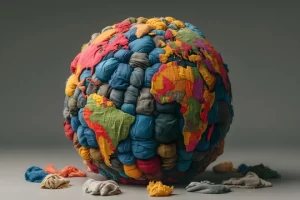 participating in clothes swapping events, and shopping second-hand are excellent ways to refresh a wardrobe without contributing to waste. Upcycling old clothes into new items and donating to charities or second-hand stores ensures they get a second life and stay out of landfills. Supporting brands that prioritise sustainability and ethical practices helps drive demand for sustainable fashion. Additionally, raising awareness about the environmental impact of fast fashion among peers and family, participating in zero-waste initiatives, and joining sustainable fashion movements can create a ripple effect. By adopting sustainable practices in their own lives, such as mindful shopping and proper clothing care, young people can set a positive example and inspire others to do the same. Through these collective efforts, the youth can significantly contribute to reducing fashion waste and fostering a more sustainable fashion industry.
participating in clothes swapping events, and shopping second-hand are excellent ways to refresh a wardrobe without contributing to waste. Upcycling old clothes into new items and donating to charities or second-hand stores ensures they get a second life and stay out of landfills. Supporting brands that prioritise sustainability and ethical practices helps drive demand for sustainable fashion. Additionally, raising awareness about the environmental impact of fast fashion among peers and family, participating in zero-waste initiatives, and joining sustainable fashion movements can create a ripple effect. By adopting sustainable practices in their own lives, such as mindful shopping and proper clothing care, young people can set a positive example and inspire others to do the same. Through these collective efforts, the youth can significantly contribute to reducing fashion waste and fostering a more sustainable fashion industry.
Thrift Fashion: Turning the tide on environmental harm
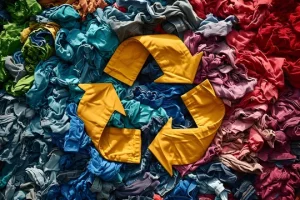 The thrift fashion culture in North East India is a remarkable testament to the region’s ingenuity and resourcefulness. Despite historical challenges such as political strife and limited access to international retail stores, the people of North East India have cultivated a robust thrifting culture that not only meets their sartorial needs but also promotes sustainability. This has transformed the perception of thrift stores by curating high-quality, stylish second-hand and vintage pieces, often showcased through beautifully shot images on social media platforms like Instagram. By embracing second-hand clothing, the youth in this part of the country are not only making fashion accessible and affordable but also championing eco-conscious practices. This vibrant thrift culture is a shining example of how sustainable fashion can thrive, blending traditional values with modern trends to create a unique and inspiring fashion landscape. In Meghalaya, the thrift shopping culture serves as a counterculture to the fast fashion economy. It significantly reduces textile waste in landfills, which can leach harmful chemicals into soil and water sources. By reducing the demand for new clothing production, thrifting helps decrease water pollution and chemical runoff from textile manufacturing. Lowering the carbon footprint of the fashion industry through thrifting can contribute to mitigating climate change impacts on public health. Second-hand clothing has often been washed multiple times, potentially reducing residual chemicals from manufacturing processes. Thrifting can decrease exposure to toxic dyes and treatments used in new clothing production. Thrift stores offer affordable clothing options, allowing lower-income individuals and families to allocate more resources to healthcare and nutrition. In fact, thrifting could be viewed as an extension of a category of fast fashion called ‘value fashion’ that provides quality fashion at an affordable rate. By extending the life of existing clothing, thrifting can help reduce the release of microfibers from new synthetic garments, which can enter the food chain and potentially impact human health.
The thrift fashion culture in North East India is a remarkable testament to the region’s ingenuity and resourcefulness. Despite historical challenges such as political strife and limited access to international retail stores, the people of North East India have cultivated a robust thrifting culture that not only meets their sartorial needs but also promotes sustainability. This has transformed the perception of thrift stores by curating high-quality, stylish second-hand and vintage pieces, often showcased through beautifully shot images on social media platforms like Instagram. By embracing second-hand clothing, the youth in this part of the country are not only making fashion accessible and affordable but also championing eco-conscious practices. This vibrant thrift culture is a shining example of how sustainable fashion can thrive, blending traditional values with modern trends to create a unique and inspiring fashion landscape. In Meghalaya, the thrift shopping culture serves as a counterculture to the fast fashion economy. It significantly reduces textile waste in landfills, which can leach harmful chemicals into soil and water sources. By reducing the demand for new clothing production, thrifting helps decrease water pollution and chemical runoff from textile manufacturing. Lowering the carbon footprint of the fashion industry through thrifting can contribute to mitigating climate change impacts on public health. Second-hand clothing has often been washed multiple times, potentially reducing residual chemicals from manufacturing processes. Thrifting can decrease exposure to toxic dyes and treatments used in new clothing production. Thrift stores offer affordable clothing options, allowing lower-income individuals and families to allocate more resources to healthcare and nutrition. In fact, thrifting could be viewed as an extension of a category of fast fashion called ‘value fashion’ that provides quality fashion at an affordable rate. By extending the life of existing clothing, thrifting can help reduce the release of microfibers from new synthetic garments, which can enter the food chain and potentially impact human health.
The thrift fashion culture in North East India, particularly in Meghalaya, serves as a model example of how sustainable fashion can thrive, blending traditional values with modern trends to create a unique and inspiring fashion landscape. As the fashion industry continues to grow, it is imperative to embrace these sustainable practices to mitigate environmental and public health impacts. By fostering a culture of sustainability, both globally and locally, we can work towards a more responsible and eco-conscious fashion industry. While thrift fashion is not a comprehensive public health solution, it does contribute to addressing several environmental and social determinants of health. By promoting sustainable consumption patterns and reducing the negative impacts of the fashion industry, thrifting can play a role in broader public health strategies aimed at creating healthier, more sustainable communities.



